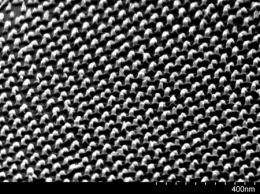Big steps in creating small chips

(PhysOrg.com) -- Plastic, heated in a simple microwave oven, is the technique researchers at the University of Alberta and the National Institute for Nanotechnology believe could help to re-invent the manufacture of computer chips.
Jillian Buriak, a U of A chemistry professor and NINT researcher, says in the drive to reduce the size of computer chips and speed up its production, her team achieved both goals.
“When we heat block copolymer plastics, which are two different plastics attached together, the molecules begin separating and naturally self-assemble,” said Buriak. She describes the self-assembly of copolymer molecules as the same natural process in which human DNA molecules recognize one another and bind together to form complex and well-defined structures.
“In the case of heat block copolymer plastics, the molecules spontaneously line up, creating nano-sized lines that act as a template for intricate circuitry patterns that can be imprinted on silicon to make computer chips.”
A computer chip with the circuitry imprint created by the self-assembly process developed by Buriak’s research team would then go through the following production process: Tiny wires, whose widths are measured in nanometres, are hundreds of times smaller than a human hair, and can be made of conducting metals, which would be laid along the circuitry lines etched into the template.
To mass produce computer chips, the industry currently uses photolithography, where light carves circuit patterns on silicon chips. Ken Harris, a NINT researcher says, “the industry is now seeking out a new generation of technologies capable of continuing the miniaturization of computer chips in a cost-effective and practical manner.”
Harris says the team’s heat and self-assembly technique produces denser patterns of lines on chips, which means an overall increase in the processing speed and storage capacity of next generation computers.
Another concern for the computer-chip industry is the amount of time it takes to turn out their products.
“The industry wants a manufacturing process that’s cheaper than photolithography for these very small feature sizes, but fast,” said Buriak. “They asked for an inexpensive self-assembly process that could work in under four minutes. With our microwave oven and copolymer plastics we produced a chip template in one minute.”
The research team is talking with potential industrial partners to further develop their process. “We’re very excited about the possibilities of the block copolymer self assembly technique, not just for computer chips, but also for tissue engineering, interfacing of living cells with silicon and other really intriguing applications,” she said.
Provided by University of Alberta


















